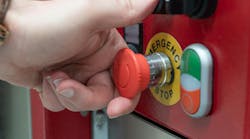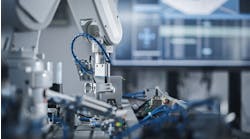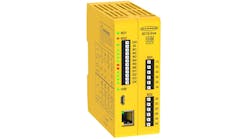Electrical engineers and technicians, computer scientists and automation programmers would naturally be interested in the latest safety devices, configurable/programmable safety controllers, distributed safety fieldbus systems, new light curtains, robotic work cell tips and the like.
The truth is that, functionally, the vast majority of the latest safety products give an identical solution to what engineers have been piecing together for the past 20 years. The key word is “functionally.” However, there is one major innovation that I feel is a game-changer.
Special safety relays were the staple of machine safety implementations back in the 1980s through the 2000s, and, through the careful selection of relay functions, and lots and lots of wiring, a solid machine-safety solution could be tailored that would be, more or less, functionally identical to a “modern” safety implementation using programmable safety controllers, black channel or dedicated safety fieldbuses and specialized safety I/O modules.
Safety relays always had wiring break detection, redundant contacts, stuck contact detection and auxiliary contacts for communicating status to the programmable logic controller (PLC) or human-machine interface (HMI). They could always be connected to form safety zones, even nested zones that allow portions of the line to be accessed by operations, maintenance or engineering while other portions of the line continued to run.
The biggest benefits that the aforementioned safety products have brought us are wiring and cost reduction and easier configuration and reconfiguration.
Much like in the 1980s when PLCs began replacing hundreds or thousands of physical relays in a factory line with a single processor running ladder logic, programmable safety controllers reduce the need for physical safety relays and replace them with a specialized controller running a limited suite of safety-specific programming instructions, logging who made the changes and when they were made, along with strong login requirements to prevent unauthorized modification to the logic.
Originally, developers of these safety controllers resisted the use of the term “programmable” and used instead the term “configurable” in an attempt to differentiate the very limited instruction set and how the instructions were used. But it seems marketing managers have settled on simply calling them “programmable safety controllers.”
Those safety relays had to be wired together with hundreds or thousands of individually terminated wires, creating a nightmare for designing, commissioning, troubleshooting and documentation. Ask any of us veterans from that era about pulling out a “paper dragon” of relay logic from the technical documentation to try and troubleshoot a bad relay or wire in a safety system. It was challenging.
Now, safety fieldbuses reduce this wiring significantly through the use of a dedicated network for safety I/O devices, or through the use of a “black channel” in the main fieldbus network that allows safety I/O and safety controllers to reliably and safely communicate.
Because of the digital nature of modern safety controllers, the status of individual safety devices—individual e-stop switches, light curtains, safety mats, enclosure doors—can be easily communicated to the operator via the HMI without any additional wiring.
This was possible with a safety relay system, but, because of the additional relays, wiring, and additional standard I/O channels involved, it was always tempting to skip these and have just a few different local indicators, which didn’t help identify why the system was in an e-stop state or a safe state.
A mirror to the effect on price of the PLC replacing expensive relay logic, safety controllers have driven the cost of a complete safety solution down to a point where hardwired safety relay solutions no longer make financial sense. Complex changes to the safety logic can be performed and tested like any other software change, without the need to bring a machine or line down for extended periods of time to rewire the logic or add relays.
In my opinion, the biggest functional advancement that the digital safety systems has brought is in motion control, specifically servo drives. Specifically, servo drives with safety functions can be instructed to stop or to go to a safe speed, a safe torque limit or a safe position. This was not an option around decade ago, and, up until then, the only safe condition for a servo was to drop the mains power, resulting in behavior that may not have been the safest, depending on the situation.
The motor could have an extended uncontrolled coast down, not the best situation if your extremity or hair is caught in a flywheel; or the depowered drive’s brake engages, possibly pinning someone to an immovable portion of the machine. The safe commands now allow people to access portions of the machine while motion is still allowed, or even interact directly with robots without fear of being injured or killed.
All being said, the evolution of safety controllers, networks and devices has changed automation for the better. Could the majority of safety needs still be implemented with safety relays? Yes. However, cost reduction, simplification of wiring and hardware and improved safety behavior has led us here, and I would not want to go back.





